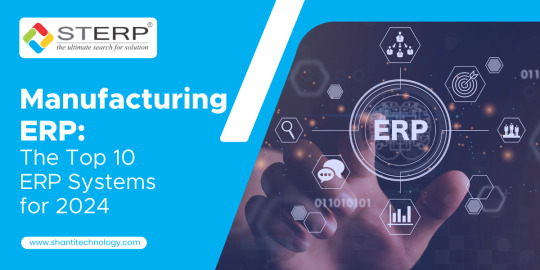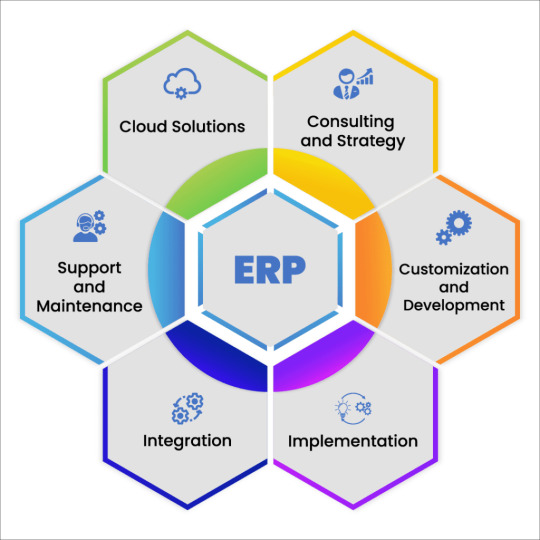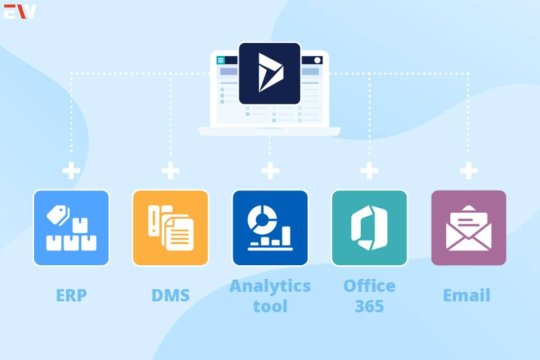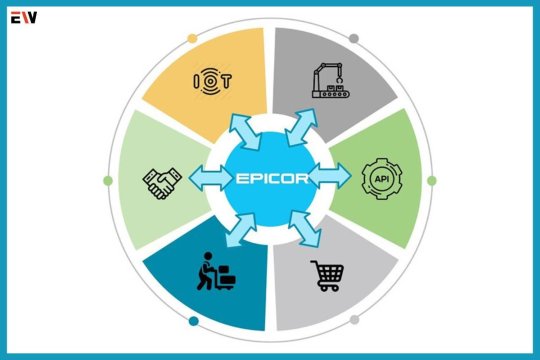#sap application integration
Explore tagged Tumblr posts
Text
Bridging Gaps in Distribution: Integrating SAP with Microsoft's Power Platform - Pinnacle The distribution industry is a complex ecosystem involving inventory management, customer service, logistics, and real-time decision-making. For businesses leveraging SAP as their core Enterprise Resource Planning (ERP) system, efficiency often hinges on maximizing the utility of their data. However, SAP alone may not always provide the level of agility and customization needed to address nuanced distribution workflows. This is where Microsoft’s Power Platform—comprising Power BI, Power Apps, and Power Automate—comes into play. When integrated with SAP, this trio empowers businesses to enhance data analysis, streamline operations, and improve customer service. Let’s explore how these tools complement SAP to transform distribution workflows. Join us now [email protected]

#Data Analysis with Power BI#Integrating Power BI with SAP#Applications of Power Apps in Distribution#SAP and Microsoft’s Power Platform
0 notes
Text
1 note
·
View note
Text
https://www.acuitilabs.com/acuitimobi/
#AcuitiMobi#Mobility as a Service#MaaS Application#Public Transport App#Simplify Travel#Integrated Transport Solution#On-Demand Public Transport#Real-time Journey Planning#Personalized User Experience#Pay-as-you-go Feature#Acuiti Labs Transportation Solutions#SAP Backend for Charging#Billing#QR Code Integration
0 notes
Text
SAP S4HANA Public Cloud Uses | SAP Gold Partner 2iSolutions
The versatility of SAP S/4HANA Public Cloud
saps4hana #SAP #sapmm
Within the modern computerized space where things are changing quickly, it has ended up exceptionally basic for businesses to discover imaginative ways of simplifying their forms conjointly remaining competitive. A conceivable arrangement that has gotten to be exceptionally prevalent is SAP S/4HANA Public Cloud. In any case, what is SAP S/4HANA Cloud after all, and what are the purposes for which it is applied? In this total and nitty gritty direct, you’ll pick up an understanding of the numerous capabilities, utilizations, additionally points of interest of SAP S/4HANA Cloud, and how it can be utilized to push business achievements.
Understanding SAP S/4HANA Cloud:
SAP S/4HANA cloud could be a cloud-based intelligent ERP (Undertaking Asset Arranging) arrangement that was created by SAP, a leading computer program firm within the endeavor space. It could be a computerized center for the organizations where they can coordinate additionally oversee all commerce capacities like funds, deals, acquirement, supply chain management, fabricating, etc., through a suite of applications. SAP S/4HANA Cloud, a flight from the on-premise ERP frameworks of the conventional sort, sends the Software-as-a-Service (SaaS) demonstrate, permitting businesses to have the adaptability, versatility, conjointly dexterity vital for them to compete successfully within the show computerized economy.
Applications of SAP S/4HANA Cloud:
Budgetary Administration:
SAP S/4HANA Cloud comes with robust Fund additionally capabilities to empower organizations to handle the bookkeeping forms, budget administration, cost following, and give real-time monetary reports.
With highlights like predictive analytics and conjointly computerized budgetary planning, organizations can pick up complex benefits like investigation of financial performance and can make well-educated choices to attain growth.
Deals and Client Relationship Administration (CRM):
The Client Relationship Administration (CRM) usefulness of SAP S/4HANA Cloud helps companies to efficiently handle client connections, bargain with the deals leads, and enhance the deals forms. Prepared with instruments such as lead scoring, opportunity administration, and too customized showcasing campaigns, companies can raise the level of client engagement and create more income.
Obtainment and Supply Chain Administration:
The SAP S/4HANA Cloud conveys procurement and supply chain administration arrangements from conclusion to end, with the assistance of which the trade can simplify sourcing, obtainment, stock administration, as well as coordination forms. With real-time see into provider execution, stock levels, and arrange status, organizations can improve their supply chain processes, cut down costs, and accomplish higher productivity.
Fabricating and Generation Arranging:
For the industry of fabricating, SAP S/4HANA Cloud gives advanced production arranging and fabricating execution functionalities. Operations include request forecasting, capacity arranging, shop floor planning, and quality administration. Organizations can optimize their manufacturing forms as well as provide the items to showcase speedier, satisfying customer demands precisely.
Rise With SAP S/4HANA Public Cloud includes an assortment of human assets and ability administration highlights that allow organizations to find, keep, and develop the finest individuals. From enlisting, and onboarding, to performance administration and learning and improvement, businesses can use their workforce techniques to move forward in worker engagement and efficiency.
#sap s/4hana#SAP S4HANA#SAP ONE#SAP BUSINESS 1#SAP FOR BUSINESS#SAP CONSULTING#SAP S4 HANA#SAP ANALYTICS CLOUD#SAP INDIA#SAP PRODUCTS#SAP APPLICATION#SAP DEVELOPER#SOLUTION MANAGEMENT SAP#SAP PARTNER#SAP SERVICE#SAP PARTNER COMPANIES#SAP HANA S4#SAP INTEGRATION#SAP BUILDING#SAP BUSINESS PARTNER#SAP IT SUPPORT#SAP Implementation#SAP Implementation Services#SAP Implementation Cost#End to End Implementation in SAP#SAP Implementation Price#SAP Erp Implementation#ERP Deployment
1 note
·
View note
Text

@puppet-limbo
I....... SCREENSHOTTED THIS SOOOO FAST!!! saved it... and now its in my computer (and my heart) forever....
INHALLLESSSS
BECAUSE RIGHT!!!
It's so mysterious because...the game really doesn't delve into more of these implications than just to say, oh!! They're rescued now! It has me... pondering... like, only if Pikmin 4 increased the demand, the urgency, such as timing... as they had it in Pikmin 1. By chance, there could've been a heightened sense of... oh no, this characters gonna die... how would this change the trajectory of the game, the story line... and all, by posing intrigue!!!
What will the "death" of this character reveal to me? Will this force me to the beginning of the game depending on its significance? Does this make me care more about my mission?
MAYBE... That'd make it convoluted -
and hopefully not as superfluous as that planetary list, but i didn't say anything
being that there's quite a handful of castaways to rescue... but... not all of them are leaflings. If there was just a little more push... a different motivation, such as to say, "Come on, recruit!!! Lives are counting on you!"
BECAUSE!!! You're in the Rescue Corps! It's no longer solely in Olimar's perspective! So, perhaps a...setback... to the mystery of leaflings was the application of the "collecting" role/formula of gameplay, (i.e, the sparklium, ship parts, and pokos)....so... with a little less "collecting" and a little more story-telling and focus on castaways, it would've allowed more room for an expansion of leaflings! With this, they could've confirmed whether it was, as you said, parasitic or DNA integration - or, at the very least, come closer to a definitive answer rather than just... ope... everything's okay now because of glow sap!
I'm so stumped too, that, in one of Olimar's logs, he reflects of the circumstances of Pikmin 2 to be a "bad dream"...

But!! Could this just be his memory loss? A side effect of being a leafling for as long as he was? BAH! A girl can dream, it just seems Pikmin 4 tossed the concepts of Pikmin 2 not to mention the obliteration of Pikmin 3 for some reason seeing that they changed the whole purpose to why Louie is on PNF-404 to begin with... or... unless... Louie forgot too...............
but that's just a theory..........
ALSO!!! AWWW thank you so so so much! I'm so flattered that you feel that way about Io and her story!! ;w; CUS SDLJHSFKJ OH GOSH, I'm confident Collin would.... do his little sad face.... like...
"Io..."
and Io's like, "It's too easy!" ... to be fair, her time as a leafling is most likely a HUGE blur! So... he's like...
"Easy?!" LKJSDFLKJSFD
#pikkissistext#no way were u rambling!! i loved reading all your tags!!#i gasped when i saw the notification like!! omg sign me up to yap about pikmin anytime#also forgive me i have not played pikmin 3 yet so i cant say anything about its gameplay SKDJFHKLJSDFH#pikmin#olimar#louie#the president pikmin#io#collin#leaflings#pikmin 2#pikmin 3#pikmin 4
21 notes
·
View notes
Text
How Do You Maintain the Color of Residential Metal Roofing?
Maintaining the vibrant color of your residential metal roofing can feel daunting, but it doesn’t have to be! You want your home to look its best, and the roof plays a key role in that curb appeal. Whether your roof is newly installed or a few years old, keeping it fresh and beautiful is achievable with simple care tips. In this guide, you’ll discover how to preserve the color of your metal roof and extend its life by following easy maintenance techniques.
Understanding Residential Metal Roofing
Before diving into maintenance, let’s briefly discuss what residential metal roofing is. These roofs are made from various metals, such as steel, aluminum, and copper, which offer durability and longevity. They are available in multiple colors and finishes, allowing homeowners to choose a style that complements their property. Because they are exposed to the elements, proper care is essential to maintain their appearance and functionality.
Regular Cleaning: The First Step to Color Maintenance
Regular cleaning is one of the best ways to maintain the color of your residential metal roofing. Over time, dirt, debris, and organic materials can accumulate on the surface, leading to discoloration and degradation.
Cleaning Frequency
Aim to clean your roof at least twice a year. In addition to routine cleanings, consider inspecting it after significant storms or if you notice any discoloration.
Cleaning Techniques
Gentle Approach: To remove dirt and debris, use a soft-bristle brush or a low-pressure power washer. Avoid harsh chemicals or abrasive materials, which can scratch and damage the paint finish.
Focus on Problem Areas: Pay special attention to areas prone to moss, algae, or tree sap. These spots can hold moisture and lead to more significant issues if not addressed promptly.
Inspecting for Damage: A Key Component of Maintenance
Regular inspections can help you catch potential issues before they escalate. Here are some tips for inspecting your residential metal roofing:
What to Look For
Rust Spots: Check for any signs of rust, particularly around seams and fasteners. Early detection can prevent larger problems later.
Paint Peeling or Fading: Look for areas where the paint is peeling or losing its luster. These areas may need touch-ups or a complete repaint.
Structural Integrity: Check for loose panels or signs of wear that could compromise the integrity of your roof.
Addressing Issues: Repair or Repaint?
Consider repairing or repainting your residential metal roofing if you notice any damage or discoloration during your inspections.
Minor Repairs
Small rust spots or peeling paint can often be addressed without a full repaint. Use touch-up paint designed for metal roofs and follow the manufacturer’s application instructions.
Full Repainting
A full repaint may be the best option if your roof is significantly faded or damaged. Here are some steps to consider before repainting:
Wait for the Right Time: If you’ve recently installed your roof, allow it to weather for about six months to ensure better paint adhesion.
Choose the Right Paint: Select specially formulated reflective paints for metal roofs to enhance energy efficiency and prolong color retention.
Choosing the Right Color for Your Residential Metal Roofing
If you’re thinking about a new color for your roof, it’s essential to choose wisely. Here are some tips:
Know Your Options
Metal roofs come in a wide array of colors. While traditional colors like gray and black remain popular, don’t shy away from vibrant hues like colonial red or deep blue.
Consider Your Home’s Style
Think about your home's architectural style. A bright color may work well in a modern design but could clash with a more traditional aesthetic.
Check HOA Guidelines
If you live, check for guidelines in a neighborhood with a homeowner's association; checking can prevent potential headaches later.
The Impact of Weather on Your Metal Roof
Weather plays a significant role in the longevity and appearance of your residential metal roofing. Here are a few factors to consider:
Sun Exposure
Constant sun exposure can lead to fading over time. If your home gets a lot of sun, consider using reflective paint to reduce heat absorption and prolong the color’s vibrancy.
Rain and Moisture
Heavy rain and moisture can cause rust and mildew. Ensure your gutters are properly clean and functioning to divert water from your roof.
Snow and Ice
Snow and ice can accumulate on a roof in colder climates. Removing heavy snow loads can help prevent structural issues and keep the roof looking fresh.
Enhancing Energy Efficiency with Your Roof Color
Did you know that your residential metal roofing color can influence your home’s energy efficiency? Choosing lighter colors can help reflect sunlight, keeping your home cooler during hot months. On the other hand, darker colors may absorb heat, which can be beneficial in colder climates.
Preserve Your Roof’s Beauty and Durability
Maintaining the color and integrity of your residential metal roofing doesn’t have to be overwhelming. By following these simple maintenance tips, you can ensure your roof looks great for years. Interested in exploring energy-efficient roofing solutions? Visit Lastime Exteriors today to learn about our services and how we can help you elevate your home’s curb appeal!
By taking proactive steps to care for your residential metal roofing, you can enjoy its beauty and durability for many years. Regular cleaning, inspections, and timely repairs will allow you to maintain the color and integrity of your roof, ensuring your home remains a stunning sight for everyone who passes by. Don’t forget to choose the right color and consider the local climate when deciding about your roofing. Happy roofing maintenance!
7 notes
·
View notes
Text
Manufacturing ERP: The Top 10 ERP Systems for 2024
Introduction:
In the dynamic landscape of the manufacturing industry, the right technology can make all the difference in streamlining processes and enhancing overall efficiency. Manufacturing Enterprise Resource Planning (ERP) systems have become indispensable tools for businesses seeking to integrate various facets of their operations seamlessly. As we step into 2024, the demand for robust ERP solutions continues to grow. In this blog, we will explore the top 10 Manufacturing ERP systems that are poised to make a significant impact on the industry this year.

1. SAP S/4HANA: Pioneering Manufacturing Resource Planning System
One of the most trusted names in ERP, SAP S/4HANA stands out as a comprehensive Manufacturing Resource Planning System. Its real-time analytics, integrated modules, and intelligent automation make it an ideal choice for businesses aiming to optimize their manufacturing processes.
2. Oracle ERP Cloud: Empowering Manufacturing Enterprise Resource Planning
Oracle ERP Cloud offers a scalable and flexible solution for manufacturing enterprises. With its robust features, it caters to the diverse needs of businesses, ensuring a seamless integration of manufacturing operations. Its cloud-based architecture provides the agility required for modern manufacturing environments.
3. Microsoft Dynamics 365: A Versatile ERP Solution
Microsoft Dynamics 365 is gaining prominence as a Manufacturing Enterprise Resource Planning software that offers versatility and integration capabilities. Its user-friendly interface and interoperability with other Microsoft products make it an attractive choice for businesses, especially small enterprises.
4. Infor CloudSuite Industrial: Tailored Manufacturing ERP
Infor CloudSuite Industrial is designed with the unique needs of manufacturers in mind. It provides specialized functionalities, including supply chain management and shop floor control, making it a standout choice among ERP solution providers.
5. NetSuite ERP: Unifying Manufacturing Operations
NetSuite ERP is recognized for its ability to unify diverse manufacturing operations into a single, cohesive system. Its cloud-based platform allows for real-time collaboration and data accessibility, making it an efficient Manufacturing Enterprise Resource Planning Software.
6. Epicor ERP: Driving Growth for Small Businesses
Epicor ERP is particularly well-suited for small businesses in the manufacturing sector. With its focus on driving growth and improving efficiency, Epicor ERP offers a cost-effective solution without compromising on essential features.
7. IFS Applications: Comprehensive ERP Solution
IFS Applications is a comprehensive ERP solution that covers a wide range of manufacturing processes. Its modular structure allows businesses to tailor the system according to their specific requirements, making it a preferred choice for Manufacturing Enterprise Resource Planning.
8. IQMS Manufacturing ERP: Enhancing Shop Floor Control
IQMS Manufacturing ERP is distinguished by its emphasis on shop floor control and real-time monitoring. It empowers manufacturers with tools to optimize production processes and make informed decisions, positioning it as a top choice among ERP solution providers.
9. Acumatica Cloud ERP: Scalability for Growing Businesses
Acumatica Cloud ERP stands out for its scalability, making it an ideal choice for growing manufacturing businesses. With a flexible platform and advanced features, Acumatica supports businesses in adapting to changing demands and expanding their operations seamlessly.
10. SYSPRO ERP: Tailored for Manufacturing Success
SYSPRO ERP is tailored to meet the specific needs of manufacturing industries. Its focus on delivering a user-friendly experience and addressing industry challenges positions it as a reliable choice for Manufacturing Enterprise Resource Planning.
Conclusion:
As manufacturing industries evolve, the importance of robust ERP systems cannot be overstated. The top 10 ERP systems highlighted in this blog represent the cutting edge of technology, offering solutions that cater to the unique demands of the manufacturing sector. Whether it's SAP S/4HANA's real-time analytics, Oracle ERP Cloud's scalability, or Acumatica Cloud ERP's flexibility, each system brings its own strengths to the table.
For businesses in Madhya Pradesh seeking Manufacturing Software for Small Business, these ERP solutions provide a pathway to enhanced productivity and streamlined operations. Choosing the right Manufacturing ERP system is a critical decision that can impact a company's growth and competitiveness. Evaluate the features, scalability, and industry focus of each system to find the perfect fit for your manufacturing enterprise. Embrace the power of ERP in 2024 and position your business for success in the ever-evolving landscape of manufacturing technology.
#Manufacturing Software for Small Business#Manufacturing Enterprise Resource Planning Software#ERP Solution Providers in Madhya Pradesh#Manufacturing Enterprise Resource Planning#Manufacturing Resource Planning System#ERP Software#Chain Cycle Management#Business#Engineering#Manufacturing#India#Madhya Pradesh#Go-To-Market#GTM#ERP
7 notes
·
View notes
Text
Discover the Best Data Modeling Tools to Elevate Your Data Strategy
In today's data-driven world, organizations increasingly rely on data modeling to turn raw data into valuable insights. As businesses accumulate vast amounts of data, the need for effective data modeling tools becomes crucial. These tools not only help in creating structured data models but also enable data architects and analysts to make informed decisions. Let's explore some of the best tools available in the market for data modeling that can transform your data management approach.
What is Data Modeling?
Data modeling is the process of creating a visual representation of a data system's structure, which includes defining the data elements and their relationships. This process aids in identifying how data will be stored, accessed, and utilized across various applications. By using data modeling, organizations can design efficient databases, minimize redundancy, and maintain data integrity, ultimately leading to better business decisions.
Top Data Modeling Tools to Consider
With a variety of tools available, selecting the right one for your business needs can be challenging. Below is a rundown of some of the most popular and effective data modeling tools used by professionals today:
ER/Studio: Known for its powerful data modeling capabilities, ER/Studio offers a comprehensive suite for designing, documenting, and managing data models. It supports both logical and physical data modeling and integrates well with major databases.
ERwin Data Modeler: A leader in the market, ERwin Data Modeler provides a user-friendly interface and supports collaboration among teams. It offers robust data governance features, ensuring consistency and compliance across data assets.
IBM InfoSphere Data Architect: This tool is ideal for enterprises needing extensive data integration and modeling capabilities. It offers a range of features, such as automated data modeling, data mapping, and reverse engineering, making it suitable for complex data environments.
Toad Data Modeler: A flexible solution for both novice and experienced data architects, Toad Data Modeler supports multiple databases and allows for efficient data model creation, validation, and modification. It also provides powerful visualization tools for easier data understanding.
PowerDesigner: Developed by SAP, PowerDesigner offers robust capabilities for data modeling, enterprise architecture, and data governance. It is particularly useful for organizations that rely heavily on SAP environments.
Choosing the Right Data Modeling Tool
The right data modeling tool can significantly impact how effectively an organization manages its data. When selecting a tool, consider factors such as ease of use, integration with existing systems, scalability, and support for different database platforms. Additionally, think about your organization's specific data modeling needs—whether you require a tool for simple data models or a comprehensive solution for complex data environments.
Why Invest in Data Modeling Tools?
Investing in effective data modeling tools offers several benefits. These tools help in designing and managing data systems that are scalable, efficient, and aligned with business objectives. They also enhance collaboration among data professionals, reduce errors, and ensure data consistency and accuracy. As data continues to grow in volume and complexity, the importance of robust data modeling tools becomes even more pronounced.
Conclusion
Data modeling is an essential practice for organizations that aim to harness the power of their data. With the right data modeling tools, businesses can design effective data architectures that support their strategic goals, drive innovation, and provide a competitive edge in the market. By understanding your organization's unique data needs and selecting the most suitable tools, you can optimize your data management processes and unlock new insights from your data.
2 notes
·
View notes
Text
The Evolution and Impact of ERP Software in the UAE: A Comprehensive Analysis
ERP stands for Enterprise Resource Planning. It is a type of software system that integrates and manages core business processes and functions within an organization. ERP software typically provides a centralized database and a suite of applications that automate and streamline business activities across various departments such as finance, human resources, supply chain management, manufacturing, sales, and customer service.
In the fast-paced landscape of business operations, efficient management of resources and information is critical for success. Enterprises in the United Arab Emirates (UAE) have witnessed a remarkable transformation in their operational efficiency and competitiveness through the adoption of Enterprise Resource Planning (ERP) software. This article delves into the evolution, benefits, challenges, and future trends of ERP software within the UAE context.
In recent decades, Enterprise Resource Planning (ERP) software has played a transformative role in how businesses in the United Arab Emirates (UAE) operate and manage their resources. This article delves into the evolution, adoption, and impact of ERP systems within the UAE's business landscape. By exploring the unique challenges and opportunities presented by the UAE's dynamic economy, we can better understand how ERP software has become an indispensable tool for organizations seeking efficiency, integration, and scalability.
Evolution of ERP Software
The adoption of ERP software in the UAE mirrors global trends but is uniquely shaped by regional business requirements and technological advancements. In the early 2000s, ERP systems gained traction among larger corporations seeking to streamline their complex processes. Major multinational ERP providers like SAP, Oracle, and Microsoft Dynamics established a strong presence in the region, catering to diverse industry needs including finance, manufacturing, retail, and logistics.
A notable development in recent times is the movement towards cloud-centric ERP solutions.This transition offers scalability, flexibility, and cost-effectiveness, allowing businesses in the UAE to manage their operations more efficiently. Local ERP vendors have also emerged, offering tailored solutions that cater specifically to the nuances of the UAE market, such as compliance with local regulations and cultural practices.
Challenges and Obstacles
Despite the numerous benefits, ERP implementation in the UAE is not devoid of challenges. One prominent obstacle is the high initial investment required for ERP deployment, including software licensing, customization, and training costs. For smaller businesses, this financial commitment can be prohibitive, leading to slower adoption rates among SMEs.
Cultural factors and change management also pose challenges. Embracing new technology often requires a shift in organizational culture and employee mindsets. Resistance to change, coupled with the need for extensive training, can hinder the successful implementation of ERP systems in the UAE.
Furthermore, data security and privacy concerns are paramount, especially in light of stringent regulatory frameworks such as the UAE's Data Protection Law. Ensuring compliance with local data protection regulations adds complexity to ERP deployment, necessitating robust cybersecurity measures and data governance protocols.
The Business Landscape of the UAE
The UAE is renowned for its vibrant economy, diversified industries, and strategic geographical location. Over the years, the country has emerged as a global business hub attracting multinational corporations, SMEs, and startups alike. Key sectors such as finance, real estate, construction, logistics, tourism, and manufacturing contribute significantly to the nation's GDP. However, this diversification has also brought complexities in managing business operations efficiently.
The Emergence of ERP Solutions
As businesses in the UAE expanded and diversified, traditional methods of managing operations became inadequate. The need for integrated systems that could streamline processes across departments led to the rise of ERP solutions. Initially developed to manage manufacturing processes, ERP systems evolved to encompass finance, human resources, supply chain, customer relationship management, and more. This evolution mirrored the growth and diversification of UAE businesses.
Factors Driving ERP Adoption
Several factors have fueled the adoption of ERP software among businesses in the UAE:
Global Competition: The UAE's aspiration to compete on a global scale necessitated advanced operational efficiencies that ERP systems could deliver.
Regulatory Compliance: The UAE's regulatory environment, including VAT implementation, required robust financial and reporting capabilities that ERP systems could provide.
Scalability: With rapid economic growth, businesses needed scalable solutions to manage increasing complexities.
Integration Needs: As businesses diversified, the need for seamless integration across functions became crucial.
Challenges in ERP Implementation
While the benefits of ERP systems are substantial, implementing them poses challenges:
Cultural Factors: Embracing technological change and adopting new systems can face resistance due to cultural factors.
Resource Constraints: SMEs may struggle with the limited resources required for ERP implementation and customization.
Data Security and Privacy: The UAE's focus on data security and privacy necessitates robust ERP solutions compliant with local regulations.
Impact of ERP on UAE Businesses
The impact of ERP software on businesses in the UAE has been profound:
Improved Efficiency: Streamlined processes lead to increased productivity and reduced operational costs.
Enhanced Decision Making: Real-time data availability empowers businesses to make informed decisions.
Better Customer Experience: Integrated systems ensure seamless customer interactions and improved service delivery.
Regulatory Compliance: ERP systems aid in meeting regulatory requirements efficiently.
Key ERP Players in the UAE
Several global and regional ERP providers cater to the UAE market, offering tailored solutions to meet local business needs. Major players include SAP, Oracle, Microsoft Dynamics, Sage, and Epicor, among others.
Future Trends and Innovations
Looking ahead, several trends are poised to shape the future of ERP software in the UAE. Artificial Intelligence (AI) and Machine Learning (ML) are increasingly integrated into ERP systems, enabling predictive analytics and automation of routine tasks. This enhances decision-making capabilities and further optimizes business processes.
Mobile ERP applications are also gaining popularity, allowing stakeholders to access critical business data on the go. The rise of Industry 4.0 and the Internet of Things (IoT) is driving demand for ERP solutions that can seamlessly integrate with smart devices and sensors, enabling real-time monitoring and control of operations.
Moreover, the convergence of ERP with other technologies like blockchain promises enhanced transparency and security in supply chain management, crucial for industries like healthcare and finance.
Conclusion
In conclusion, ERP software has become an integral component of the UAE's business ecosystem, driving efficiency, integration, and growth across diverse sectors. While challenges exist, the transformative impact of ERP systems on businesses in the UAE underscores their importance in navigating complex operational landscapes. As technology continues to evolve, so too will the role of ERP in shaping the future of business in the UAE.ERP software has emerged as a transformative tool for businesses in the UAE, driving efficiency, innovation, and competitiveness across industries. Despite challenges such as high costs and cultural adaptation, the benefits of ERP implementation are substantial, ranging from streamlined operations to improved customer satisfaction. Looking ahead, the evolution of ERP software in the UAE is poised to align with global technological advancements, incorporating AI, IoT, and blockchain to unlock new possibilities for business growth and development. As enterprises continue to navigate the digital landscape, ERP remains a cornerstone of strategic management, enabling organizations to thrive in an increasingly complex and dynamic marketplace.
In summary, ERP software has been a game-changer for businesses in the UAE, enabling them to streamline operations, enhance decision-making, and adapt to a rapidly evolving marketplace. As the UAE continues to position itself as a global economic powerhouse, the role of ERP systems will remain pivotal in supporting the growth and sustainability of businesses across various sectors.
2 notes
·
View notes
Text
ABOUT US
We offer unique software solutions to grow your business. We are group of experienced software architect, engineers, testers and project managers. We have built many applications and products using several technologies..
AmpleServ products and solutions are used worldwide. With vertical focus toward best industry solutions Enterprise Resource Planning (ERP), Hotel Management, Social Media Apps, HCM Payroll Solution, e-Commerce, Integration Systems, Project Management and several products to extend core functionality of SAP Business One. Apart from the streamlined services, we offer a bunch of products..
2 notes
·
View notes
Text
Charting the Course to SAP HANA Cloud
The push towards SAP HANA cloud shift stems from the need for agility and responsiveness in a dynamic business climate. The cloud promises reduced infrastructure expenses, robust data analytics, and the nimbleness to address changing needs quickly. However, for many companies, transitioning from on-premise SAP HANA to the cloud involves navigating concerns around data security, performance, and potentially relinquishing control of business-critical ERP systems.
SAP HANA Enterprise Cloud: A Tailored Offering
In light of these challenges, SAP presented the SAP HANA Enterprise Cloud (HEC), a private cloud service designed expressly for mission-critical workloads. HEC advertises no compromise on performance, integration, security, failover, or disaster recovery. It spotlights versatility, strong customer support, and end-to-end coverage - from strategic planning to application management. This offering intends to provide the cloud’s agility and innovation under SAP’s direct guidance and expertise.
Actual Delivery of HANA Enterprise Cloud
Despite SAP’s messaging, the HEC’s delivery involves a consortium of third-party providers, including HPE, IBM, CenturyLink, Dimension Data, and Virtustream. SAP collaborates with these partners, who bid on projects often awarded to the lowest bidder, to leverage specialized capabilities while upholding SAP’s standards.
Weighing the Pros and Cons
Partnering with competent vendors ensures clients receive secure, best-practice SAP hosting and support. HEC’s comprehensive solution integrates licensing, infrastructure, and support with touted scalability and integration.
However, several customer challenges emerge. Firstly, leveraging SAP’s brand for cloud hosting and SAP managed services risks diminishing anticipated cost savings. Secondly, the lack of direct engagement with third-party providers raises concerns about entrusting critical ERP operations to unseen partners. This dynamic obscures visibility and control over SAP HANA migration and management.
Furthermore, the absence of a direct relationship between SAP HANA users and cloud suppliers may complicate support, especially for urgent issues warranting rapid response. While SAP’s ecosystem aims to guarantee quality and security, intermediation can hinder the timely resolution of critical situations, affecting system uptime and operations.
SAP HANA Cloud: A Strategic Decision
As SAP systems become increasingly vital, migrating SAP HANA is not simply a technical or operational choice but a strategic one. SAP HANA transcends a database or software suite – it constitutes a competitive advantage that, when optimized, can spur tremendous innovation and success. This migration necessitates meticulous planning, execution, and governance to ensure the transition empowers rather than compromises SAP HANA’s strategic value.
In this context, selecting the ideal cloud model and service providers represents critical decisions. Companies must scrutinize partners beyond cost, evaluating track records, SAP skills, security protocols, and the aptitude to deliver personalized, responsive service.
The Future SAP HANA Cloud Trajectory
As we advance into 2024, the SAP DATA Cloud Analytics landscape continues evolving. Innovations in cloud technology, security, and service creation provide new prospects for migration planning. Firms must stay updated on cloud service advancements, SAP’s strategic direction, and cloud shift best practices to navigate this transition successfully.
To accomplish this, companies should:
Collaborate cross-functionally to align SAP HANA cloud plans with broader business goals and technology roadmaps.
Ensure chosen cloud environments and suppliers meet rigorous data security, privacy, and regulatory standards.
Assess infrastructure ability to support SAP HANA performance requirements and scale amid fluctuating demands.
Institute clear governance and support structures for effective issue resolution throughout and post-migration.
Transitioning SAP HANA to the cloud is complex but ultimately rewarding, unlocking efficiency, agility, and innovation when executed deliberately. By weighing the strategic, operational, and technical dynamics, businesses can drive this migration smoothly, fully capturing SAP HANA’s power to fuel future prosperity.
2 notes
·
View notes
Text
Exploring the Significance of ERP Software: How It Works, Why It's Vital for Companies, and the Benefits for Your Business
Enterprise Resource Planning (ERP) software stands as the backbone of modern businesses, planning a masterpiece of operations seamlessly. This comprehensive suite of integrated applications manages core business processes, including finance, HR, inventory, supply chain, and more. Its significance lies in its ability to streamline operations, enhance efficiency, and foster data-driven decision-making.
Cloud-based ERP solutions offer a versatile edge over traditional on-premises systems. They facilitate real-time data accessibility, scalability, and cost-effectiveness. Conversely, on-premises ERP software provides robust security and customization options, ideal for businesses with specific compliance needs or intricate operational structures.
Adopting the best ERP Software Consulting Solutions is a strategic move for companies, as it centralizes disparate processes into a unified platform, eradicates data silos, and enhances collaboration, thereby boosting productivity and offering a comprehensive view of the business for smarter, data-backed decisions."

The benefits of ERP software for your business are multifaceted. It optimizes resource utilization, streamlines workflows, minimizes errors, and accelerates reporting cycles. This ultimately results in improved customer satisfaction, reduced operational costs, and better agility in responding to market changes.
When seeking the best ERP software development services, solutions, implementation, or consulting, businesses must prioritize expertise, reliability, and compatibility. The best ERP software development services and solutions cater to unique business needs, offering tailor-made solutions for seamless integration and functionality.
Choosing the best ERP software implementation services or solutions involves a thorough evaluation of the provider's track record, customer reviews, and adaptability to your company's requirements. Expert ERP software consulting services navigate businesses through the maze of choices, ensuring optimal software selection, implementation, and long-term success.
In conclusion, the strategic implementation of ERP software can revolutionize business operations, driving efficiency, innovation, and competitiveness. Selecting the best ERP software development, implementation, and consulting services is pivotal for maximizing the benefits and leveraging the full potential of this transformative technology.
ERP Offerings & Practice's
SAP/S4 HANA ERP Software Solutions
Ellucian Banner ERP Software Solutions
Peoplesoft ERP Software services
Oracle Cloud ERP Software services
UKG ERP Software services
Salesforce ERP Software services
3 notes
·
View notes
Text
What is the best IFRS software
Best International Financial Reporting Standards (IFRS) software because the choice of software depends on the specific needs and requirements of the organization. Different companies may have distinct preferences based on factors such as size, industry, complexity of financial reporting, and integration capabilities with existing systems.
However, there are several reputable software solutions that are commonly used for IFRS reporting and compliance. Keep in mind that the landscape might have changed, and new solutions may have emerged since my last update.
Workiva:
Workiva offers cloud-based solutions for finance, compliance, and data management. It is known for its collaborative and workflow management features.
Tagetik (owned by Wolters Kluwer):
Tagetik provides a unified platform for financial performance management, including IFRS reporting. It is designed to streamline funds processes and improve compliance.
Oracle Financial Services Analytical Applications (OFSAA):
Oracle's OFSAA suite includes modules for various budgetary functions, including regulatory info. It is designed to help wealthy institutions comply with IFRS and other reporting standards.
SAP S/4HANA:
SAP's ERP solution, S/4HANA, includes financial modules that can support IFRS. SAP is widely used in large enterprises across various industries.
Datar ails:
Data Rails offers a platform that automates funds reporting, budgeting, and forecasting. It is designed to improve the accuracy and efficiency of income processes.
Hubble (by insight software):
Hubble is an integrated suite of performance management apps. It provides solutions for financial reporting, analytics, and planning.
OneStream Software:
OneStream offers a unified CPM (Corporate Performance Management) platform that includes solutions for financial consolidation and planning, supporting IFRS compliance.
When choosing an IFRS software solution, it's essential to consider factors such as the organization's specific information needs, budget, scalability, ease of use, and integration capabilities with existing systems. Additionally, staying informed about updates and reviews in the financial software market is crucial to ensuring that the chosen solution meets the latest standards and regulations.
2 notes
·
View notes
Text
The Crucial ERP System Examples: Transforming Business Operations

In today’s fiercely competitive business realm, the quest for operational efficiency and streamlined management is paramount. Enterprise Resource Planning (ERP) systems stand tall as technological marvels, revolutionizing the way businesses operate. These robust software solutions amalgamate various functions within a unified framework, enabling seamless coordination across departments and facilitating data-driven decision-making.
This exploration ventures into the realm of ERP systems, shedding light on a spectrum of exemplary solutions that have reshaped modern business operations. From stalwarts like SAP ERP and Oracle ERP Cloud to innovative players like Microsoft Dynamics 365 and Odoo, each system represents a unique amalgamation of features, functionalities, and industry applications.
This comprehensive journey traverses the functionalities, industry adaptability, and transformative potentials of these ERP systems. Understanding their intricacies is pivotal for businesses seeking to optimize processes, unlock efficiencies, and navigate the complexities of today’s business landscape. Join this insightful exploration to unravel the significance and impact of these ERP system examples in shaping the future of business operations.
ERP System Examples
1. SAP ERP: Revolutionizing Business Management
SAP ERP has solidified its position as a leader by providing an all-encompassing suite covering critical business functions. Beyond its core modules in finance, HR, and supply chain, SAP offers specialized applications for industry-specific needs. For instance, SAP S/4HANA, an intelligent ERP, integrates AI and analytics for real-time insights, empowering businesses to adapt swiftly to market changes.
The scalability of SAP ERP is noteworthy, catering to startups aiming for growth and global corporations managing complex operations. It provides modular solutions, enabling businesses to adopt specific functionalities based on their immediate needs.
2. Oracle ERP Cloud: Innovating Operations in the Cloud
Oracle ERP Cloud’s robust suite extends far beyond traditional ERP capabilities. It embraces emerging technologies like AI, machine learning, and blockchain to drive innovation. Its predictive analytics empower businesses to anticipate market trends, optimize supply chains, and mitigate risks effectively.
The cloud-based structure of Oracle ERP Cloud ensures not just accessibility but also scalability without compromising security. It enables seamless integration with other Oracle Cloud applications, fostering a unified ecosystem for comprehensive business management.
3. Microsoft Dynamics 365: Integrating CRM and ERP Capabilities

Microsoft Dynamics 365 is a fusion of CRM and ERP functionalities, providing a holistic platform for businesses. Unlike its core ERP modules, Dynamics 365 offers advanced tools for customer engagement, field service, and marketing automation. Its flexibility lies in its modularity, allowing businesses to tailor their systems by choosing specific applications that align with their objectives.
Moreover, its integration with Microsoft Office 365 and Power Platform strengthens collaboration and data analysis, facilitating informed decision-making across departments.
4. NetSuite: Empowering Diverse Industries
NetSuite’s cloud-based ERP system addresses the complex needs of various industries. Its suite encompasses solutions for financial management, e-commerce, and inventory control. Beyond the core ERP functionalities, NetSuite offers industry-specific modules, such as SuiteCommerce for retail businesses and SuiteSuccess for services, enhancing its appeal across diverse sectors.
The scalability and adaptability of NetSuite make it a preferred choice for businesses experiencing rapid growth or seeking to expand into new markets.
5. Infor ERP: Tailored Solutions for Specific Sectors
Infor’s industry-specific ERP solutions cater to the nuanced requirements of sectors like healthcare, manufacturing, and distribution. In addition to its standard ERP functionalities, Infor focuses on specialized applications such as Infor CloudSuite Healthcare for healthcare organizations and Infor LN for manufacturing, ensuring tailored solutions for sector-specific challenges.
Infor’s commitment to innovation and addressing sector-specific complexities underscores its relevance in the ERP landscape.
6. Epicor ERP: Amplifying Industry Operations

Epicor ERP excels in catering to industries such as manufacturing, distribution, retail, and services. Its core ERP functionalities are complemented by advanced analytics and business intelligence tools. Epicor’s Smart Inventory Planning and Optimization (IPO) tool, for instance, utilizes AI to enhance inventory management, improving efficiency and reducing costs.
Moreover, its agile architecture enables easy customization and integration with third-party applications, providing businesses with a highly adaptable solution.
7. Odoo: Flexibility and Customization
Odoo’s open-source ERP system offers an extensive suite of applications covering CRM, inventory management, project management, and more. What sets Odoo apart is its modular nature, allowing businesses to select and integrate specific applications as per their requirements. Odoo’s flexibility and affordability are especially beneficial for small to medium-sized enterprises seeking customizable solutions without exorbitant costs.
The Value of ERP Systems in Modern Business
ERP systems serve as catalysts for efficiency, productivity, and growth:
Streamlined Operations: Automating tasks streamlines processes, reducing manual errors and optimizing resource allocation.
Enhanced Data Management: Centralized databases ensure data consistency and accuracy, fostering informed decision-making.
Agile Decision-Making: Real-time data access empowers businesses to make agile decisions, staying ahead in dynamic markets.
Customer-Centric Approach: Integrated CRM functionalities enable businesses to deliver personalized services, boosting customer satisfaction and loyalty.
Making Informed Choices: Selecting the Right ERP System

The process of choosing an ERP system involves careful evaluation and alignment with a business’s unique needs. Understanding the scalability, integration capabilities, and industry-specific functionalities of each system is crucial for successful adoption.
Conclusion: Embracing ERP Systems for Sustainable Growth
The landscape of ERP systems continues to evolve, offering businesses versatile solutions to streamline operations, enhance efficiency, and foster sustainable growth. From SAP’s scalability to Oracle’s cloud-driven innovation and Odoo’s customization prowess, each system exemplifies the diverse capabilities shaping modern business management.
Selecting the right ERP system aligned with specific needs remains pivotal for organizations seeking resilience and competitiveness. As businesses strive for optimization and adaptability, embracing these transformative technologies ensures a strategic advantage in an ever-evolving market. It stands as a pillar of efficiency, empowering businesses to navigate complexities and drive success through informed decisions and streamlined operations.
Also Read: A Deep Dive into Corporate Wellness Programs for a Healthier, Happier Workplace
#ERPRevolution#BusinessTransformation#TechInnovation#DigitalTransformation#EnterpriseSolutions#InnovationInBusiness#TechLeadership
2 notes
·
View notes
Text
Top-Ranked SAP Training Institutes in Amravati | SAPALOGY

Why Choose Amravati for SAP Training?
Opting for SAP training in Amravati presents a compelling choice for several reasons. The city's burgeoning industrial presence and dynamic economic landscape make it an ideal location for professionals seeking to enhance their skills in SAP (Systems, Applications, and Products in Data Processing). Here are key considerations that make Amravati a favorable destination for SAP training:
Growing Industrial Hub: Amravati has experienced substantial industrial growth, establishing itself as a notable hub for various sectors. This growth translates into a wealth of opportunities for SAP professionals, as businesses increasingly integrate SAP solutions to streamline their operations.
Vibrant Economic Environment: The city boasts a vibrant economic environment, with diverse industries contributing to its economic prosperity. This diversity ensures that SAP professionals trained in Amravati gain exposure to a broad spectrum of real-world business scenarios, enhancing their practical skills.
Rising Demand for SAP Experts: As businesses in Amravati continue to recognize the efficiency and effectiveness of SAP, there is a heightened demand for skilled SAP professionals. Choosing to undergo SAP training in Amravati positions individuals at the forefront of this demand, increasing their employability and career prospects.
Networking Opportunities: Amravati's status as an emerging business hub provides ample networking opportunities. SAP training institutes often collaborate with local businesses, offering students valuable connections with industry professionals. This networking can prove instrumental in securing internships, projects, and job placements.
Cost-Effective Training Options: Compared to larger metropolitan areas, the cost of living and training in Amravati tends to be more affordable. This cost-effectiveness extends to SAP training programs, making it an attractive choice for individuals seeking quality education without an exorbitant financial burden.
Quality Training Institutes: Amravati is home to reputable SAP training institutes that prioritize quality education. These institutes often tailor their programs to meet the specific needs of the local industry, ensuring that graduates are well-equipped to navigate the challenges of the regional business landscape.
Cultural and Regional Relevance: Training in Amravati provides a unique advantage of cultural and regional relevance. Understanding the local business culture and practices can be advantageous when applying SAP skills in the context of businesses operating in and around Amravati.
In conclusion, choosing SAP training in Amravati aligns with the city's economic dynamism, rising demand for SAP professionals, networking opportunities, cost-effectiveness, presence of quality training institutes, and cultural relevance. Aspiring SAP professionals can capitalize on these factors to receive comprehensive training and position themselves for success in the competitive job market.
To know more-
2 notes
·
View notes
Text
Hiring an Ecommerce Agency: The Complete Guide
“Great web design without functionality is like a sports car with no engine.” – Paul Cookson
When it comes to launching or upgrading your ecommerce presence, the stakes are high and the opportunities boundless. In a digital ecosystem brimming with potential, a proficient ecommerce agency is your navigator, engineer, and co-pilot all in one. But not all agencies are created equal. This guide will walk you through the essential points to consider when hiring an ecommerce agency, ensuring your business gears up for success in the virtual marketplace.
Identifying Your Ecommerce Needs
Before you even begin the hunt for an ecommerce agency, it’s crucial to have a clear understanding of your needs. Are you looking for an impressive Shopify Plus store development? Or perhaps, your needs are more tailored towards intricate UI/UX design for your ecommerce store. Custom application development, integrations with ERP/SAP systems, syncing with an offline store, or other bespoke customizations might be on your checklist. Knowing your exact requirements will streamline the hiring process and lead to more productive conversations with potential agencies.
Experience Matters
Look for a partner with a proven track record. An experienced ecommerce agency brings to the table years of know-how, a portfolio of diverse clients, and the capability to handle the complexity of your project. Being a Shopify Plus partner, for instance, is a significant indicator of an agency’s expertise in delivering top-tier ecommerce solutions. The right agency should have not only the knowledge but also the seasoned skills to elevate your online store.
The Art of Customization
The digital landscape is not one-size-fits-all. Your chosen agency should excel in custom application development and integrations. The ability to tailor your ecommerce store to seamlessly connect with ERP systems or synchronize with your brick-and-mortar outlets can give you a competitive edge.
If your goal is to ensure your digital platform operates in harmony with your physical outlets, reach out to us. Our proficiency in custom integrations stands as a testament to our commitment to your business growth.
Why Choose Us?
As a Shopify Plus partner and a seasoned team of 80 professionals, we are not just experts; we are artisans of the ecommerce space. For over two decades, Binary Web Solutions India Private Limited has been at the forefront of ecommerce excellence, driving sales and enhancing user experiences.
Our commitment to quality and our comprehensive suite of services, from UI/UX design to custom integrations, set us apart. We understand that your online store is the heart of your digital business, and we are dedicated to making it thrive.
In Conclusion,
Choosing the right ecommerce agency is a pivotal decision. With the right partner, you’ll not only build an online store, but you’ll create an ecommerce experience that resonates with your brand and your customers. Remember, it’s not just about going digital; it’s about becoming a digital destination.
Interested in learning how we can help you achieve that? [Get in touch with us today]and embark on a journey of ecommerce excellence with a partner that truly understands the digital retail landscape.
Let’s create something exceptional together.
To know more: https://binaryic.com/hiring-an-ecommerce-agency-the-complete-guide/

2 notes
·
View notes